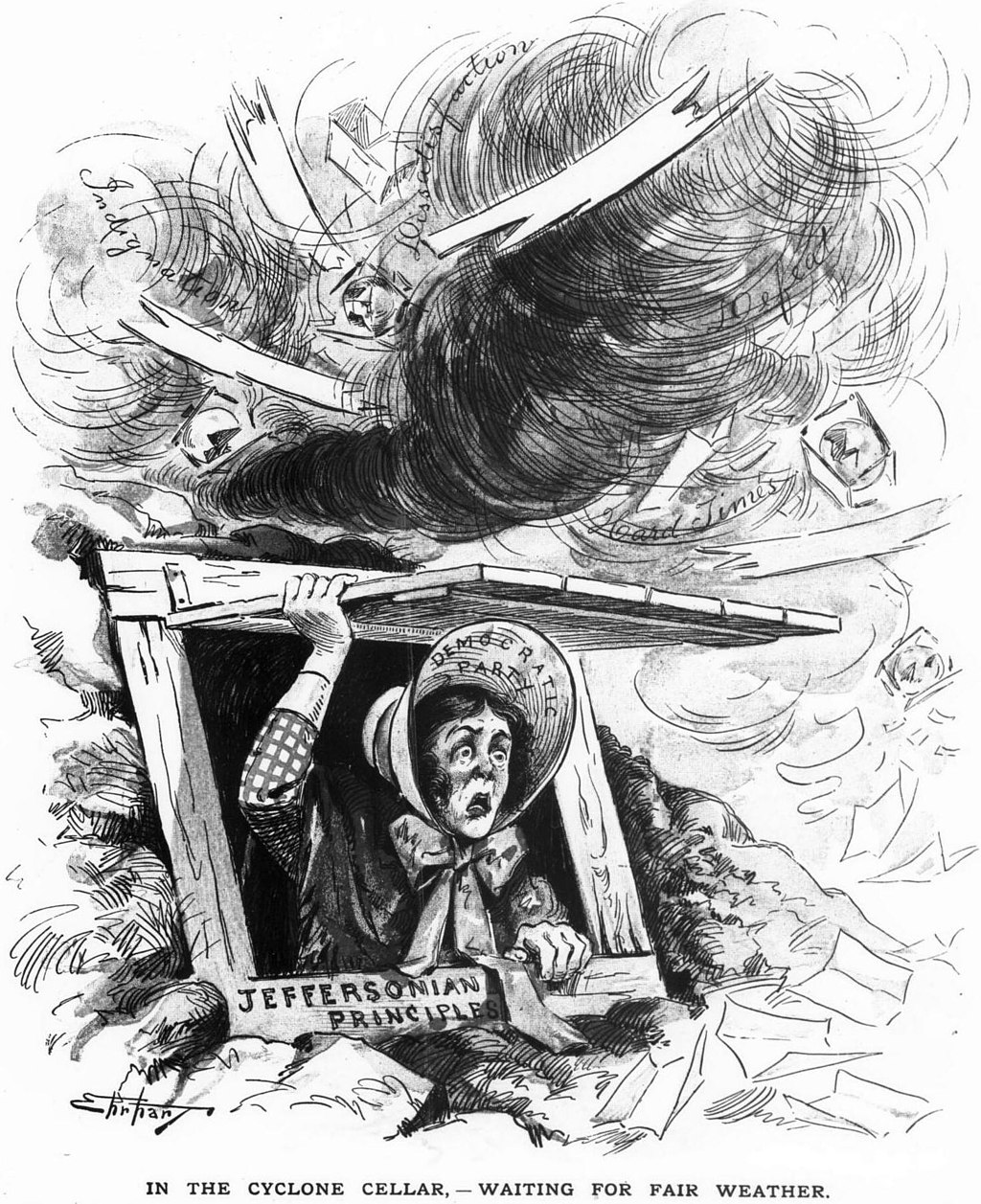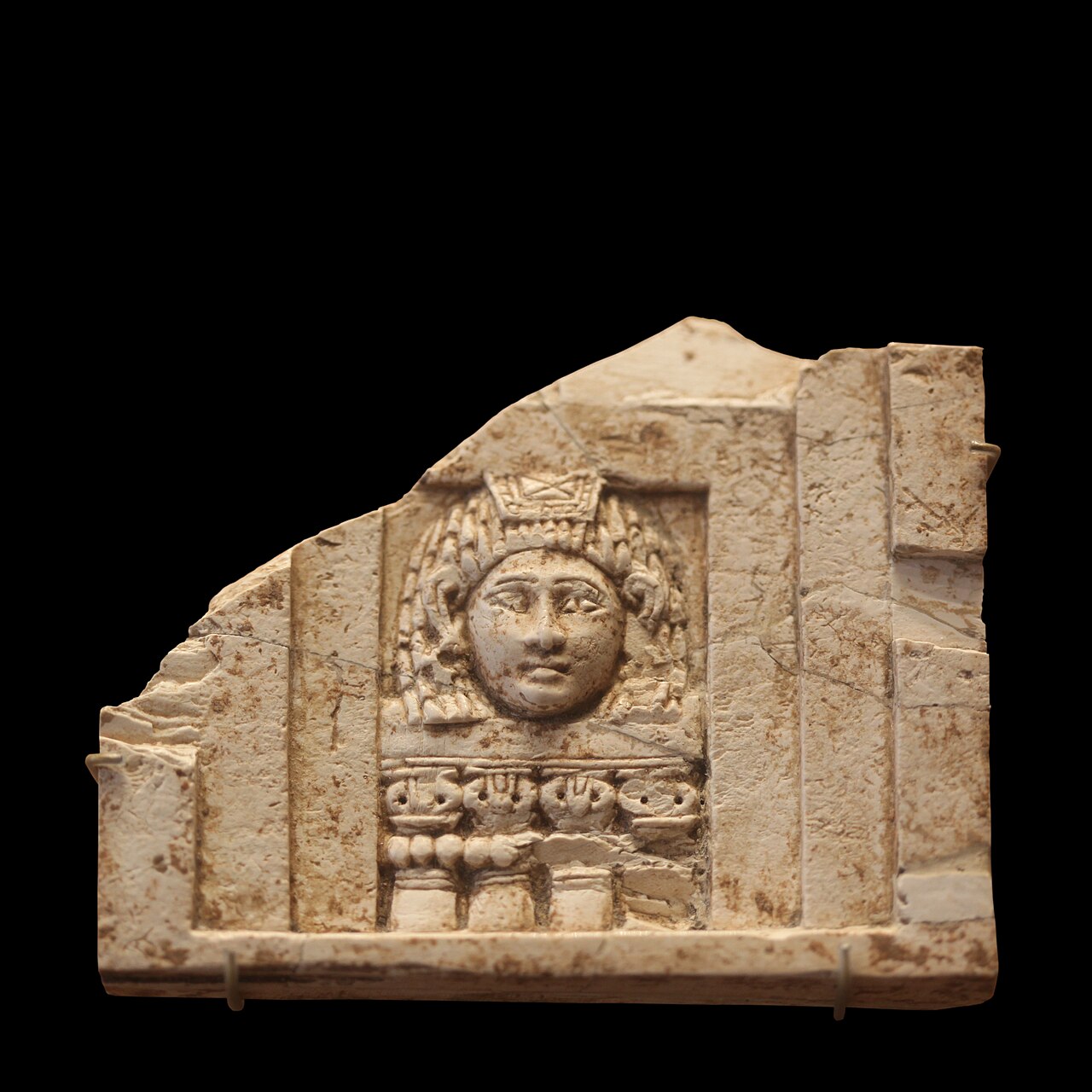
隠喩
metaphor

☆ 隠喩(metaphor):いんゆ・メタファーとは、全体を全体で表象するような表現によるものだ。表象による表現することの中に は、喩(たと)えという修辞が使われるために、表象よりも曖昧 なものがあり、それは隠喩(いんゆ、メタファー)と呼ばれる。隠喩は、換喩(かんゆ)との対比のなかで、より狭く定義すれば、全体を全体で表象するような 修辞(=表現のシステム)である。隠喩の例は、王をライオンで表象するようなものである。なぜならばライオンは動物の中の王、頂点に君臨するものだから、 そして王もまた王国の頂点に君臨するから。
★︎︎隠喩・換喩・提喩の三者の意味の違いをてっとり早く知りたい方はこちらを参照に→「︎隠喩・換喩・提喩」「隠喩と換喩」それぞれ異なるページです.
A
political cartoon by illustrator S.D. Ehrhart in an 1894 Puck magazine
shows a farm-woman labeled "Democratic Party" sheltering from a tornado
of political change. |
1894年の雑誌『パック』に掲載されたイラストレーターS.D.エハートの政治風刺漫画には、「民主党」とラベル付けされた農家の女性が、政治の変化による竜巻から身を隠している様子が描かれている。 |
| A metaphor
is a figure of speech that, for rhetorical effect, directly refers to
one thing by mentioning another.[1] It may provide (or obscure) clarity
or identify hidden similarities between two different ideas. Metaphors
are usually meant to create a likeness or an analogy.[2] Analysts group metaphors with other types of figurative language, such as antithesis, hyperbole, metonymy, and simile.[3] “Figurative language examples include “similes, metaphors, personification, hyperbole, allusions, and idioms.””[4] One of the most commonly cited examples of a metaphor in English literature comes from the "All the world's a stage" monologue from As You Like It: All the world's a stage, And all the men and women merely players; They have their exits and their entrances And one man in his time plays many parts, His Acts being seven ages. At first, the infant... —William Shakespeare, As You Like It, 2/7[5] This quotation expresses a metaphor because the world is not literally a stage, and most humans are not literally actors and actresses playing roles. By asserting that the world is a stage, Shakespeare uses points of comparison between the world and a stage to convey an understanding about the mechanics of the world and the behavior of the people within it. In the ancient Hebrew psalms (around 1000 B.C.), one finds vivid and poetic examples of metaphor such as, "The Lord is my rock, my fortress and my deliverer; my God is my rock, in whom I take refuge, my shield and the horn of my salvation, my stronghold" and "The Lord is my shepherd, I shall not want". Some recent linguistic theories view all language in essence as metaphorical.[6] The etymology of a word may uncover a metaphorical usage which has since become obscured with persistent use - such as for example the English word "window", etymologically equivalent to "wind eye".[7] The word metaphor itself is a metaphor, coming from a Greek term meaning 'transference (of ownership)'. The user of a metaphor alters the reference of the word, "carrying" it from one semantic "realm" to another. The new meaning of the word might derive from an analogy between the two semantic realms, but also from other reasons such as the distortion of the semantic realm - for example in sarcasm. |
隠喩とは、修辞的な効果を狙って、ある物事を直接的に言及する代わりに別の物事を言及する表現技法である。[1] 隠喩は、2つの異なる概念間の隠れた類似性を明らかにしたり、不明瞭にしたりする。隠喩は通常、類似性や類似性を生み出すことを目的としている。[2] アナリストは隠喩を、反意語、誇張、換喩、類似などの他の比喩的言語と分類している。[3] 「比喩的言語の例としては、「類似、隠喩、擬人法、誇張、暗示、慣用表現」などがある。」[4] 英語文学における隠喩の最もよく引用される例のひとつは、お気に召すままの「All the world's a stage」というモノローグである。 「この世はすべて舞台だ。 そして男も女もみな役者にすぎない。 彼らには出番もあれば退場もある。 そして人は一生の間に多くの役を演じる。 その人の一生は7つの時代に分かれる。最初は赤ん坊として... —ウィリアム・シェイクスピア『お気に召すまま』第2幕第7場[5] この引用は隠喩を表現している。なぜなら、世界は文字通り舞台ではないし、ほとんどの人間は文字通り役を演じる俳優や女優ではないからだ。世界は舞台であ ると主張することで、シェイクスピアは世界と舞台の類似点を挙げ、世界の仕組みと、その中での人々の行動についての理解を伝えている。 古代ヘブライ語の詩篇(紀元前1000年頃)には、「主は私の岩、私の砦、私の救い主。私の神は私の岩、私はその方に身を避け、私の盾、私の救いの角、私 の砦」や「主は私の羊飼い、私は欠乏することがない」といった、生き生きとした詩的な隠喩の例が見られる。最近の言語学説のいくつかでは、すべての言語は 本質的には隠喩であると見なしている。[6] 語源をたどると、隠喩的な用法が明らかになることがある。その用法は、その後、使用が繰り返されるうちに不明瞭になってしまったものである。例えば、英語 の「window」という語は語源的には「wind eye」と同義である。[7] 隠喩という言葉自体が隠喩であり、それは「所有権の移転」を意味するギリシャ語に由来する。隠喩を使用する人は、その言葉の参照先を変更し、ある意味上の 「領域」から別の意味上の「領域」へと「移す」のである。その言葉の新しい意味は、2つの意味上の領域間の類似性から派生する場合もあるが、意味上の領域 の歪み、例えば皮肉など、他の理由から派生する場合もある。 |
| Etymology The English word metaphor derives from the 16th-century Old French word métaphore, which comes from the Latin metaphora, 'carrying over', and in turn from the Greek μεταφορά (metaphorá), 'transference (of ownership)',[8] from μεταφέρω (metapherō), 'to carry over, to transfer'[9] and that from μετά (meta), 'behind, along with, across'[10] + φέρω (pherō), 'to bear, to carry'.[11] |
語源 英語の「隠喩」という語は、16世紀の古フランス語の「隠喩」に由来し、さらにラテン語の「持ち越し」を意味する「メタフォラ」に由来する。また、ギリ シャ語の「所有権の移転」を意味する「メタフォラ」に由来し、さらに「持ち越し、移転」を意味する「メタフェロー」に由来する。「後ろ、一緒に、向こう」 [10] + φέρω (pherō), 「耐える、運ぶ」[11] |
| Parts of a metaphor The Philosophy of Rhetoric (1936) by rhetorician I. A. Richards describes a metaphor as having two parts: the tenor and the vehicle. The tenor is the subject to which attributes are ascribed. The vehicle is the object whose attributes are borrowed. In the previous example, "the world" is compared to a stage, describing it with the attributes of "the stage"; "the world" is the tenor, and "a stage" is the vehicle; "men and women" is the secondary tenor, and "players" is the secondary vehicle. Other writers[which?] employ the general terms ground and figure to denote the tenor and the vehicle. Cognitive linguistics uses the terms target and source, respectively. Psychologist Julian Jaynes coined the terms metaphrand and metaphier, plus two new concepts, paraphrand and paraphier.[12][13] Metaphrand is equivalent to the metaphor-theory terms tenor, target, and ground. Metaphier is equivalent to the metaphor-theory terms vehicle, figure, and source. In a simple metaphor, an obvious attribute of the metaphier exactly characterizes the metaphrand (e.g. "the ship plowed the seas"). With an inexact metaphor, however, a metaphier might have associated attributes or nuances – its paraphiers – that enrich the metaphor because they "project back" to the metaphrand, potentially creating new ideas – the paraphrands – associated thereafter with the metaphrand or even leading to a new metaphor. For example, in the metaphor "Pat is a tornado", the metaphrand is Pat; the metaphier is tornado. As metaphier, tornado carries paraphiers such as power, storm and wind, counterclockwise motion, and danger, threat, destruction, etc. The metaphoric meaning of tornado is inexact: one might understand that 'Pat is powerfully destructive' through the paraphrand of physical and emotional destruction; another person might understand the metaphor as 'Pat can spin out of control'. In the latter case, the paraphier of 'spinning motion' has become the paraphrand 'psychological spin', suggesting an entirely new metaphor for emotional unpredictability, a possibly apt description for a human being hardly applicable to a tornado. Based on his analysis, Jaynes claims that metaphors not only enhance description, but "increase enormously our powers of perception...and our understanding of [the world], and literally create new objects".[12]: 50 |
隠喩の構成要素 修辞学者I. A. リチャーズの著書『修辞学の哲学』(1936年)では、隠喩を「テノール」と「ビークル」という2つの構成要素を持つものとして説明している。テノールと は、属性が帰属される主題である。一方、vehicle(乗り物)は、属性を借用する対象である。先の例では、「世界」が「舞台」と比較され、「舞台」の 属性で描写されている。「世界」がtenor(主語)であり、「舞台」がvehicle(乗り物)である。「男性と女性」は二次的なtenorであり、 「役者」は二次的なvehicleである。 他の作家[誰?]は、一般的な用語である「地」と「図」をそれぞれテナーとビークルを表すのに用いている。認知言語学では、それぞれ「対象」と「ソース」という用語が用いられている。 心理学者ジュリアン・ジェインズは、「メタフランド」と「メタフィア」という用語を造語し、さらに「パラフランド」と「パラフィア」という2つの新しい概 念を提唱した。[12][13] メタフランドは、隠喩理論における「テナー」、「対象」、「地」に相当する。メタフィアは、隠喩理論におけるビークル、フィギュア、ソースに相当する。単 純な隠喩では、メタフィアの明白な属性がメタフラウンドを正確に特徴づける(例えば、「船は海を耕した」)。しかし、不正確な隠喩では、メタフィアは関連 する属性やニュアンス、すなわちパラフィアを持つ可能性がある。それらはメタフラントに「投影」され、潜在的にメタフラントに関連する新たなアイデア、す なわちパラフラントを生み出し、さらには新たな隠喩につながる可能性もある。例えば、「パットは竜巻だ」という隠喩では、メタフラントはパットであり、メ タフィアは竜巻である。メタファーとしてのトルネードには、力、嵐、風、反時計回りの動き、危険、脅威、破壊などのパラフィアンスが含まれる。トルネード の隠喩的な意味は曖昧である。ある人は、物理的および感情的な破壊というパラフィアンスを通じて、「パットは強力に破壊的である」と理解するかもしれな い。また、別の人は、この隠喩を「パットは制御不能に暴走する可能性がある」と理解するかもしれない。後者の場合、「回転する動き」の言い換えが「心理的 な混乱」という別の言い換えとなり、感情の予測不可能性というまったく新しい隠喩を示唆している。これは、竜巻には当てはまらないが、人間には当てはまる 可能性がある表現である。ジェインズは、この分析に基づいて、隠喩は記述を向上させるだけでなく、「人間の知覚能力を飛躍的に高め、[世界に対する]理解 力を高め、文字通り新しい対象を創り出す」と主張している。[12]:50 |
As a type of comparison "The Asherah is part of a jigsaw in weaving together the feminine threads of a religious history that could be an important new breakthrough for women, she says."[14] An example of mixed metaphor in print. Metaphors are most frequently compared with similes. A metaphor asserts the objects in the comparison are identical on the point of comparison, while a simile merely asserts a similarity through use of words such as like or as. For this reason a common-type metaphor is generally considered more forceful than a simile.[15][16] The metaphor category contains these specialized types: Allegory: An extended metaphor wherein a story illustrates an important attribute of the subject. Antithesis: A rhetorical contrast of ideas by means of parallel arrangements of words, clauses, or sentences.[17] Catachresis: A mixed metaphor, sometimes used by design and sometimes by accident (a rhetorical fault). Hyperbole: Excessive exaggeration to illustrate a point.[18] Parable: An extended metaphor told as an anecdote to illustrate or teach a moral or spiritual lesson, such as in Aesop's fables or Jesus' teaching method as told in the Bible. Pun: A verbal device by which multiple definitions of a word or its homophones are used to give a sentence multiple valid readings, typically to humorous effect. Similitude: An extended simile or metaphor that has a picture part (Bildhälfte), a reality part (Sachhälfte), and a point of comparison (tertium comparationis).[19] Similitudes are found in the parables of Jesus. It is said that a metaphor is 'a condensed analogy' or 'analogical fusion' or that they 'operate in a similar fashion' or are 'based on the same mental process' or yet that 'the basic processes of analogy are at work in metaphor'. It is also pointed out that 'a border between metaphor and analogy is fuzzy' and 'the difference between them might be described (metaphorically) as the distance between things being compared'.[This quote needs a citation] |
比較の一種として 「アシェラは、宗教の歴史における女性的な糸を織り合わせるジグソーパズルの一部であり、それは女性にとって重要な新たな突破口となる可能性がある、と彼女は言う」[14] 印刷物における混合隠喩の一例。 隠喩は、類似表現と比較されることが最も多い。隠喩は、比較の対象が比較の点において同一であると主張するが、類似表現は、like や as などの言葉を使用して単に類似性を主張するだけである。このため、一般的なタイプの隠喩は、一般的に直喩よりも強い表現力を持つと考えられている。 [15][16] 隠喩のカテゴリーには、以下の専門用語が含まれる。 寓話:主題の重要な属性を物語で説明する拡張された隠喩。 アンチテーゼ:言葉、節、または文を並列に配置することで、観念を修辞的に対比させること。[17] カタクリシス:意図的に、あるいは偶発的に(修辞的な欠陥)使用される混合隠喩。 誇張:主張を説明するための過剰な誇張。 たとえ話:道徳的または精神的な教訓を説明または教えるために、逸話として語られる拡張隠喩。例えば、イソップ寓話や聖書に語られるイエスの教え方など。 言葉遊び:言葉や同音異義語の複数の定義を、文章に複数の有効な読みを与えるために使用する言語技法。通常、ユーモアを狙ったものである。 類似:絵の部分(Bildhälfte)、現実の部分(Sachhälfte)、比較のポイント(tertium comparationis)を持つ、拡張された類似表現または隠喩。類似表現は、イエスのたとえ話に見られる。 隠喩は「凝縮された類似」または「類推的融合」である、あるいは「同様の方法で作用する」または「同じ精神過程に基づく」または「隠喩の基本プロセスは類 似の作用である」とされる。また、「隠喩と類似の境界は曖昧である」ことや、「両者の違いは(隠喩的に)比較されるものの間の距離として説明できる」こと も指摘されている。[この引用には出典が必要] |
| Metaphor vs metonymy Main article: Metaphor and metonymy Metaphor is distinct from metonymy, as the two concepts embody different fundamental modes of thought. Metaphor works by bringing together concepts from different conceptual domains, whereas metonymy uses one element from a given domain to refer to another closely related element. A metaphor creates new links between otherwise distinct conceptual domains, whereas a metonymy relies on pre-existent links within such domains. For example, in the phrase "lands belonging to the crown", the word crown is a metonymy because some monarchs do indeed wear a crown, physically. In other words, there is a pre-existent link between crown and monarchy.[20] On the other hand, when Ghil'ad Zuckermann argues that the Israeli language is a "phoenicuckoo cross with some magpie characteristics", he is using metaphor.[21]: 4 There is no physical link between a language and a bird. The reason the metaphors phoenix and cuckoo are used is that on the one hand hybridic Israeli is based on Hebrew, which, like a phoenix, rises from the ashes; and on the other hand, hybridic Israeli is based on Yiddish, which like a cuckoo, lays its egg in the nest of another bird, tricking it to believe that it is its own egg. Furthermore, the metaphor magpie is employed because, according to Zuckermann, hybridic Israeli displays the characteristics of a magpie, "stealing" from languages such as Arabic and English.[21]: 4–6 |
隠喩と換喩 詳細は「隠喩」および「換喩」を参照 隠喩と換喩は異なる概念であり、異なる思考様式を体現している。隠喩は異なる概念領域から概念を結びつけることで機能するが、換喩は特定の領域から1つの 要素を取り出し、別の密接に関連する要素を参照する。隠喩は、それ以外では異なる概念領域間に新たなつながりを作り出すが、換喩は、そのような領域内に存 在する既存のつながりに依存する。 例えば、「王冠に属する土地」という表現では、「王冠」という言葉は隠喩である。なぜなら、一部の君主は実際に物理的に王冠を被っているからだ。言い換え れば、王冠と君主制の間には、すでに存在するつながりがある。[20] 一方、ギラード・ズッカーマンがイスラエルの言語は「カササギの特性を持つフェニックスの交雑種」であると主張している場合、彼は隠喩を使用している。 [21]: 4 言語と鳥の間には物理的なつながりはない。隠喩としてのフェニックスとカッコウが用いられる理由は、ハイブリッド・イスラエル語が、フェニックスのように 灰の中から蘇るヘブライ語を基盤としていること、そして、ハイブリッド・イスラエル語が、カッコウのように他の鳥の巣に自分の卵であると騙して卵を産み付 けるイディッシュ語を基盤としていることによる。さらに、隠喩としてのカササギが用いられているのは、ズックマンによると、ハイブリッド・イスラエル語が アラビア語や英語などの言語から「盗んだ」カササギの特徴を示しているからである。[21]:4-6 |
| Subtypes A dead metaphor is a metaphor in which the sense of a transferred image has become absent. The phrases "to grasp a concept" and "to gather what you've understood" use physical action as a metaphor for understanding. The audience does not need to visualize the action; dead metaphors normally go unnoticed. Some distinguish between a dead metaphor and a cliché. Others use "dead metaphor" to denote both.[22] A mixed metaphor is a metaphor that leaps from one identification to a second inconsistent with the first, e.g.: I smell a rat [...] but I'll nip him in the bud" — Irish politician Boyle Roche This form is often used as a parody of metaphor itself: If we can hit that bull's-eye then the rest of the dominoes will fall like a house of cards... Checkmate. — Futurama character Zapp Brannigan.[23] An extended metaphor, or conceit, sets up a principal subject with several subsidiary subjects or comparisons. In the above quote from As You Like It, the world is first described as a stage and then the subsidiary subjects men and women are further described in the same context. An implicit metaphor has no specified tenor, although the vehicle is present. M. H. Abrams offers the following as an example of an implicit metaphor: "That reed was too frail to survive the storm of its sorrows". The reed is the vehicle for the implicit tenor, someone's death, and the storm is the vehicle for the person's sorrows.[24] Metaphor can serve as a device for persuading an audience of the user's argument or thesis, the so-called rhetorical metaphor. |
サブタイプ 死んだ隠喩とは、転移されたイメージの意味が欠如した隠喩である。「概念を把握する」や「理解したことをまとめる」という表現は、理解を比喩する物理的な 動作を用いている。聴衆は動作を視覚化する必要はなく、死んだ隠喩は通常気づかれない。死んだ隠喩と決まり文句を区別する人もいる。また、「死んだ隠喩」 という用語で両者を指す人もいる。 混合隠喩とは、ある特定から、最初のものと矛盾する別のものへと飛躍する隠喩である。例えば、 「何か裏があるような気がするが、まだ芽のうちに摘んでしまう」 —アイルランドの政治家ボイル・ローチ この形式は、隠喩そのもののパロディとしてよく使われる。 「あの的を射抜くことができれば、残りのドミノはまるでトランプの家のように倒れるだろう... チェックメイトだ。 —『フューチャラマ』のキャラクター、ザップ・ブラニガン。 [23] 拡張された隠喩、または誇張表現では、主要な主題をいくつかの従属的な主題や比較によって設定する。『お気に召すまま』からの上記の引用では、まず世界が舞台として描写され、その同じ文脈で、従属的な主題である男性と女性がさらに描写されている。 暗喩には、乗り物はあるが、特定の主題はない。M. H. アブラムスは、隠喩の例として次の文章を挙げている。「その葦は悲しみの嵐を生き延びるにはあまりにもか弱かった」。葦は隠喩の主題である「誰かの死」を 暗示するものであり、嵐は「その人の悲しみ」を暗示するものである。[24] 隠喩は、ユーザーの主張や論文を聴衆に納得させるための手法として用いられることもある。いわゆる修辞的隠喩である。 |
| In rhetoric and literature Aristotle writes in his work the Rhetoric that metaphors make learning pleasant: "To learn easily is naturally pleasant to all people, and words signify something, so whatever words create knowledge in us are the pleasantest."[25] When discussing Aristotle's Rhetoric, Jan Garret stated "metaphor most brings about learning; for when [Homer] calls old age "stubble", he creates understanding and knowledge through the genus, since both old age and stubble are [species of the genus of] things that have lost their bloom."[26] Metaphors, according to Aristotle, have "qualities of the exotic and the fascinating; but at the same time we recognize that strangers do not have the same rights as our fellow citizens".[27] Educational psychologist Andrew Ortony gives more explicit detail: "Metaphors are necessary as a communicative device because they allow the transfer of coherent chunks of characteristics -- perceptual, cognitive, emotional and experiential – from a vehicle which is known to a topic which is less so. In so doing they circumvent the problem of specifying one by one each of the often unnameable and innumerable characteristics; they avoid discretizing the perceived continuity of experience and are thus closer to experience and consequently more vivid and memorable."[28] As style in speech and writing As a characteristic of speech and writing, metaphors can serve the poetic imagination. This allows Sylvia Plath, in her poem "Cut", to compare the blood issuing from her cut thumb to the running of a million soldiers, "redcoats, every one"; and enabling Robert Frost, in "The Road Not Taken", to compare a life to a journey.[29][30][31] Metaphors can be implied and extended throughout pieces of literature. |
修辞学と文学において、 アリストテレスは『修辞学』の中で、隠喩は学習を楽しくすると書いている。「容易に学ぶことは、当然ながらすべての人にとって快い。そして言葉は何かを意 味する。だから、どのような言葉であれ、私たちの中に知識を生み出すものは、最も快いものである」[25] アリストテレスの『弁論術』について論じる際、ヤン・ギャレットは「隠喩は最も学習をもたらす。なぜなら、ホメーロスが老年を「無精ひげ」と呼ぶとき、彼 は属を通じて理解と知識を生み出す。なぜなら、老年も無精ひげも、ともに花を失ったもの(の属)だからである」と述べている。 [26] アリストテレスによれば、隠喩には「エキゾチックで魅惑的な性質がある。しかし同時に、私たちは見知らぬ人には同胞と同じ権利はないことを認識している」 [27]。 教育心理学者のアンドリュー・オルトニーは、より明確な詳細を述べている。「隠喩は、知覚、認知、感情、経験といった一貫したまとまりのある特性を、周知 のものからあまり知られていないものへと伝えるコミュニケーションの手段として必要である。そうすることで、名指しが不可能で数えきれない特性を一つひと つ特定するという問題を回避し、知覚される経験の連続性を断片化することを避け、経験により近づくことができるため、より生き生きとして記憶に残りやすく なる」[28] 話し方や書き方におけるスタイルとして 話し方や書き方の特徴として、隠喩は詩的な想像力を生み出すことができる。このため、シルヴィア・プラスは詩「Cut」で、切った親指から流れ出る血を 「赤い軍服を着た100万の兵士」の行進に例えることができ、ロバート・フロストは「The Road Not Taken」で人生を旅に例えることができる。 隠喩は文学作品全体に暗示され、広げられることもある。 |
| Larger applications Sonja K. Foss characterizes metaphors as "nonliteral comparisons in which a word or phrase from one domain of experience is applied to another domain".[32] She argues that since reality is mediated by the language we use to describe it, the metaphors we use shape the world and our interactions to it.  A metaphorical visualization of the word anger The term "metaphor" can characterise basic or general aspects of experience and cognition: A cognitive metaphor is the association of object to an experience outside the object's environment. A conceptual metaphor is an underlying association that is systematic in both language and thought. A root metaphor is the underlying worldview that shapes an individual's understanding of a situation. A nonlinguistic metaphor is an association between two nonlinguistic realms of experience. A visual metaphor uses an image to create the link between different ideas. |
より大きなアプリケーション ソニア・K・フォスは、隠喩を「ある経験領域の単語やフレーズを別の経験領域に適用する非直喩的な比較」と定義している。[32] 彼女は、現実を描写する際に使用する言語によって現実が媒介されるため、使用する隠喩が世界とそれに対する我々の相互作用を形作ると主張している。  「怒り」という言葉を隠喩的に視覚化したもの 「隠喩」という用語は、経験や認知の基本的な側面や一般的な側面を特徴づけることができる。 認知的な隠喩とは、対象物の環境外での経験と対象物との関連付けである。 概念的な隠喩とは、言語と思考の両方において体系化された潜在的な関連付けである。 根本的な隠喩とは、個人の状況に対する理解を形成する潜在的な世界観である。 非言語的な隠喩とは、2つの非言語的な経験領域間の関連付けである。 視覚的な隠喩とは、異なる概念間の関連性をイメージによって表現するものである。 |
| Conceptual metaphors Main article: Conceptual metaphor Some theorists have suggested that metaphors are not merely stylistic, but are also cognitively important. In Metaphors We Live By (1980), George Lakoff and Mark Johnson argue that metaphors are pervasive in everyday life, not only in language but also in thought and action. A common definition of metaphor presents it as a comparison that shows how two things, which are not alike in most ways, are similar in another important way. In this context, metaphors contribute to the creation of multiple meanings within polysemic complexes across different languages.[33] Furthermore, Lakoff and Johnson explain that a metaphor is essentially the understanding and experiencing of one kind of thing in terms of another, which they refer to as a "conduit metaphor". According to this view, a speaker can put ideas or objects into containers and then send them along a conduit to a listener, who removes the object from the container to make meaning of it. Thus, communication is conceptualized as something that ideas flow into, with the container being separate from the ideas themselves. Lakoff and Johnson provide several examples of daily metaphors in use, including "argument is war" and "time is money". These metaphors occur widely in various contexts to express personal meanings. In addition, the authors suggest that communication can be viewed as a machine: "Communication is not what one does with the machine, but is the machine itself."[34] Moreover, experimental evidence shows that "priming" people with material from one area can influence how they perform tasks and interpret language in a metaphorically related area.[note 1] Omnipresent metaphor may provide an indicator for researching the functionality of language.[36] |
概念的隠喩 詳細は「概念的隠喩」を参照 一部の理論家は、隠喩は単に文体の問題ではなく、認知上も重要であると主張している。1980年に出版された『Metaphors We Live By(我々が生きる隠喩)』の中で、ジョージ・レイコフとマーク・ジョンソンは、隠喩は言語のみならず思考や行動においても日常的に浸透していると主張し ている。隠喩の一般的な定義では、ほとんどの点で似ていない2つのものが、別の重要な点で類似していることを示す比較として説明される。この文脈におい て、隠喩は異なる言語における多義語複合概念の多義性の創出に寄与する。[33]さらに、レイコフとジョンソンは、隠喩とは本質的にはあるものを別のもの として理解し経験することであり、彼らはこれを「導管隠喩」と呼ぶと説明している。この見解によると、話し手はアイデアや対象を容器に入れ、それを導管を 通して聞き手に送る。聞き手は容器から対象を取り出し、意味を理解する。このように、コミュニケーションはアイデアが流れ込むものとして概念化され、容器 はアイデアそのものとは別物である。レイコフとジョンソンは、日常的に使用されている隠喩の例として、「議論は戦争である」や「時は金なり」などを挙げて いる。これらの隠喩は、個人的な意味を表現するために、さまざまな文脈で広く使用されている。さらに、著者はコミュニケーションを機械として捉えることが できると示唆している。「コミュニケーションとは、機械を使って行うことではなく、機械そのものである」[34] さらに、ある分野の資料を「プライミング」することで、人々がタスクを遂行する方法や、隠喩的に関連する分野の言語を解釈する方法に影響を与える可能性があることが、実験により示されている。[注1] いたるところに存在する隠喩は、言語の機能性を研究するための指標となる可能性がある。[36] |
| As a foundation of our conceptual system Cognitive linguists emphasize that metaphors serve to facilitate the understanding of one conceptual domain—typically an abstraction such as "life", "theories" or "ideas"—through expressions that relate to another, more familiar conceptual domain—typically more concrete, such as "journey", "buildings" or "food".[37][38] For example: one devours a book of raw facts, tries to digest them, stews over them, lets them simmer on the back-burner, regurgitates them in discussions, and cooks up explanations, hoping they do not seem half-baked. A convenient short-hand way of capturing this view of metaphor is the following: Conceptual Domain (A) is Conceptual Domain (B), which is what is called a conceptual metaphor. A conceptual metaphor consists of two conceptual domains, in which one domain is understood in terms of another. A conceptual domain is any coherent organization of experience. For example, we have coherently organized knowledge about journeys that we rely on in understanding life.[38] Lakoff and Johnson greatly contributed to establishing the importance of conceptual metaphor as a framework for thinking in language, leading scholars to investigate the original ways in which writers used novel metaphors and to question the fundamental frameworks of thinking in conceptual metaphors. From a sociological, cultural, or philosophical perspective, one asks to what extent ideologies maintain and impose conceptual patterns of thought by introducing, supporting, and adapting fundamental patterns of thinking metaphorically.[39] The question is to what extent the ideology fashion and refashion the idea of the nation as a container with borders, and how enemies and outsiders are represented. [citation needed] Some cognitive scholars have attempted to take on board the idea that different languages have evolved radically different concepts and conceptual metaphors, while others hold to the Sapir-Whorf hypothesis. German philologist Wilhelm von Humboldt (1767-1835) contributed significantly to this debate on the relationship between culture, language, and linguistic communities. Humboldt remains, however, relatively unknown in English-speaking nations. Andrew Goatly, in "Washing the Brain", takes on board the dual problem of conceptual metaphor as a framework implicit in the language as a system and the way individuals and ideologies negotiate conceptual metaphors. Neural biological research suggests that some metaphors are innate, as demonstrated by reduced metaphorical understanding in psychopathy.[40] James W. Underhill, in Creating Worldviews: Ideology, Metaphor & Language (Edinburgh UP), considers the way individual speech adopts and reinforces certain metaphoric paradigms. This involves a critique of both communist and fascist discourse. Underhill's studies are situated in Czech and German, which allows him to demonstrate the ways individuals are thinking both within and resisting the modes by which ideologies seek to appropriate key concepts such as "the people", "the state", "history", and "struggle". Though metaphors can be considered to be "in" language, Underhill's chapter on French, English and ethnolinguistics demonstrates that language or languages cannot be conceived of in anything other than metaphoric terms. Several other philosophers have embraced the view that metaphors may also be described as examples of a linguistic "category mistake" which have the potential of leading unsuspecting users into considerable obfuscation of thought within the realm of epistemology. Included among them is the Australian philosopher Colin Murray Turbayne.[41] In his book The Myth of Metaphor, Turbayne argues that the use of metaphor is an essential component within the context of any language system which claims to embody richness and depth of understanding.[42] In addition, he clarifies the limitations associated with a literal interpretation of the mechanistic Cartesian and Newtonian depictions of the universe as little more than a "machine" – a concept which continues to underlie much of the scientific materialism which prevails in the modern Western world.[43] He argues further that the philosophical concept of "substance" or "substratum" has limited meaning at best and that physicalist theories of the universe depend upon mechanistic metaphors which are drawn from deductive logic in the development of their hypotheses.[44][45][43] By interpreting such metaphors literally, Turbayne argues that modern man has unknowingly fallen victim to only one of several metaphorical models of the universe which may be more beneficial in nature.[46][43][47] In his book In Other Shoes: Music, Metaphor, Empathy, Existence Kendall Walton also places the formulation of metaphors at the center of a "Game of Make Believe," which is regulated by tacit norms and rules. These "principles of generation" serve to determine several aspects of the game which include: what is considered to be fictional or imaginary, as well as the fixed function which is assumed by both objects and people who interact in the game. Walton refers to such generators as "props" which can serve as means to the development of various imaginative ends. In "content oriented" games, users derive value from such props as a result of the intrinsic fictional content which they help to create through their participation in the game. As familiar examples of such content oriented games, Walton points to putting on a play of Hamlet or "playing cops and robbers". Walton further argues, however, that not all games conform to this characteristic.[48] In the course of creating fictions through the use of metaphor we can also perceive and manipulate props into new improvised representations of something entirely different in a game of "make-believe". Suddenly the properties of the props themselves take on primary importance. In the process the participants in the game may be only partially conscious of the "prop oriented" nature of the game itself.[49][50][51] |
概念体系の基礎として 認知言語学者は、隠喩が、より身近な概念領域(通常は「人生」、「理論」、「アイデア」などの抽象概念)に関連する表現を通じて、ある概念領域(通常は 「旅」、「建物」、「食べ物」などのより具体的な概念)の理解を促進する役割を果たすことを強調している。 [37][38] 例えば、生々しい事実を詰め込んだ本を読み、それを消化しようとし、煮込み、後回しにして煮込み、議論で吐き出し、中途半端な説明にならないよう説明を練 り上げる。 この隠喩の概念を簡潔に表現する便利な方法として、概念領域(A)は概念領域(B)であり、これがいわゆる概念隠喩である。概念隠喩は2つの概念領域から 構成され、そのうちの1つの領域はもう一方の領域から理解される。概念領域とは、経験のまとまりのある組織化を指す。例えば、私たちは人生を理解する上で 頼りにしている旅に関する知識をまとまりのある形で組織化している。 レイコフとジョンソンは、言語による思考の枠組みとしての概念的隠喩の重要性を確立することに大きく貢献し、学者たちに作家たちが新しい隠喩を使用した本来の方法の調査を促し、概念的隠喩における思考の根本的な枠組みに疑問を投げかけた。 社会学、文化論、哲学の観点から見ると、イデオロギーが隠喩的な思考の基本パターンを導入、支持、適応させることによって、思考の概念的パターンを維持 し、押し付ける程度が問われる。[39] 問題は、イデオロギーが国境を持つ容器としての国民の概念をどの程度作り上げ、作り直すか、そして敵や部外者がどのように表現されるかである。[要出典] 一部の認知学者は、異なる言語には根本的に異なる概念や概念的隠喩が発展してきたという考え方を採用しようとしているが、一方で、サピア=ウォーフの仮説 を支持する学者もいる。ドイツの言語学者ヴィルヘルム・フォン・フンボルト(1767-1835)は、文化、言語、言語共同体間の関係に関するこの議論に 大きく貢献した。しかし、フンボルトは英語圏では依然としてあまり知られていない。アンドリュー・ゴートリーは著書『Washing the Brain』の中で、言語というシステムに潜在する枠組みとしての概念的隠喩と、個人やイデオロギーが概念的隠喩をどう解釈するかという2つの問題を取り 上げている。神経生物学の研究では、精神病患者における隠喩の理解力の低下が示しているように、一部の隠喩は生得的なものであることが示唆されている。 ジェームズ・W・アンダーヒルは著書『Creating Worldviews: Ideology, Metaphor & Language』(エジンバラ大学出版)において、個人の話し方が特定の隠喩的パラダイムを採用し、強化する過程について考察している。これは、共産主 義とファシズムの言説の両方に対する批判を含んでいる。アンダーヒルの研究はチェコ語とドイツ語を対象としているため、個人が「人民」、「国家」、「歴 史」、「闘争」などの主要概念をイデオロギーが利用しようとする際に、その方法に抵抗しながら、またその方法の中で、どのように考えているかを明らかにす ることが可能となっている。 隠喩は「言語の流行」であると考えられることもあるが、アンダーヒルのフランス語、英語、民族言語学に関する章では、言語または言語は隠喩的な用語以外では考えられないことを示している。 他の複数の哲学者も、隠喩は言語の「範疇混同」の例として説明できるという見解を受け入れている。この「範疇混同」は、認識論の領域において、疑いを持た ないユーザーを思考の大幅な混乱に導く可能性がある。その中には、オーストラリアの哲学者コリン・マレー・ターベインも含まれる。ターベインは著書『隠喩 の神話』の中で、隠喩の使用は、理解の豊かさや深みを体現するあらゆる言語体系において不可欠な要素であると主張している。[42] さらに、ターベインは、デカルト主義やニュートン主義による宇宙の機械論的描写を文字通りに解釈することに伴う限界を明らかにしている。。この概念は、現 代の西洋世界に浸透している科学的唯物論の多くを根底で支え続けている。[43] さらに、彼は「実体」や「基質」といった哲学的な概念はせいぜい限定的な意味しか持たず、宇宙の物理主義理論は、仮説の展開において演繹論理から導き出さ れた機械論的隠喩に依存していると論じている。 [44][45][43] ターベインは、このような隠喩を文字通りに解釈することで、現代人は知らず知らずのうちに、より本質的に有益であるかもしれない宇宙のいくつかの隠喩モデ ルのうちの1つにのみ犠牲者となっていると主張している。[46][43][47] ケンダル・ウォルトン(Kendall Walton)は著書『In Other Shoes: Music, Metaphor, Empathy, Existence』の中で、暗黙の規範やルールによって規制される「想像のゲーム」の中心に隠喩の形成を位置づけている。これらの「生成の原則」は、 ゲームのいくつかの側面を決定する役割を果たしており、その中には、フィクションや想像とみなされるもの、およびゲーム内で相互作用するオブジェクトや人 物が想定する固定機能が含まれる。ウォルトンは、このようなジェネレーターを「小道具」と呼び、さまざまな想像上の結末を導く手段として役立つと述べてい る。「コンテンツ志向型」ゲームでは、ユーザーはゲームへの参加を通じて作り出す本質的なフィクションの内容の結果として、このような小道具から価値を引 き出す。ウォルトンは、このようなコンテンツ志向型ゲームの身近な例として、ハムレットの劇を演じたり、「警官と泥棒ごっこ」をしたりすることを挙げてい る。しかし、ウォルトンはさらに、すべてのゲームがこの特性に当てはまるわけではないと主張している。[48] 隠喩を用いてフィクションを創造する過程で、私たちは小道具を認識し、操作して、まったく異なる何かを即興で表現することもできる。「ごっこ遊び」のゲー ムでは、 突如として小道具そのものの特性が最も重要な意味を持つようになる。その過程において、ゲームの参加者は、ゲーム自体が「小道具志向」であるという性質を 部分的にしか意識していないかもしれない。[49][50][51] |
Nonlinguistic metaphors Tombstone of a Jewish woman depicting broken candles, a visual metaphor of the end of life Metaphors can map experience between two nonlinguistic realms. Musicologist Leonard B. Meyer demonstrated how purely rhythmic and harmonic events can express human emotions.[52] Art theorist Robert Vischer argued that when we look at a painting, we "feel ourselves into it" by imagining our body in the posture of a nonhuman or inanimate object in the painting. For example, the painting The Lonely Tree by Caspar David Friedrich shows a tree with contorted, barren limbs.[53] Looking at the painting, some recipients may imagine their limbs in a similarly contorted and barren shape, evoking a feeling of strain and distress.[citation needed] Nonlinguistic metaphors may be the foundation of our experience of visual and musical art, as well as dance and other art forms.[54][55] |
非言語的隠喩 ろうそくが折れている様子を描いた、あるユダヤ人女性の墓碑。これは人生の終わりを視覚的に表現した隠喩である 隠喩は、2つの非言語的領域間の経験を関連付けることができる。音楽学者レナード・B・マイヤーは、純粋にリズムとハーモニーのイベントが人間の感情を表現できることを実証した。[52] 美術理論家のロバート・フィッシャーは、絵画を鑑賞する際、絵画の中の人間以外のものや無生物の姿勢に自分の体を重ね合わせることによって、「絵画の中に 自分自身を感じる」と主張した。例えば、カスパー・ダーヴィト・フリードリヒの絵画『孤独な木』には、ねじれて不毛な枝を持つ木が描かれている。[53] この絵画を鑑賞する人の中には、自分の手足が同様にねじれて不毛な形になっている姿を想像し、緊張や苦痛の感情を呼び起こす人もいるかもしれない。[要出 典] 非言語的な隠喩は、視覚芸術や音楽芸術、ダンスやその他の芸術形式の体験の基礎となっている可能性がある。[54][55] |
| In historical linguistics In historical onomasiology or in historical linguistics, a metaphor is defined as a semantic change based on a similarity in form or function between the original concept and the target concept named by a word.[56] For example, mouse: "small, gray rodent with a long tail" → "small, gray computer device with a long cord". Some recent linguistic theories hold that language evolved from the capability of the brain to create metaphors that link actions and sensations to sounds.[6] |
歴史言語学において 歴史的オノマシオロジーまたは歴史言語学において、隠喩とは、元の概念と、言葉によって名付けられた対象概念との間の形態または機能における類似性に基づく意味の変化と定義される。 例えば、「小さな灰色のネズミで長い尾を持つ」→「小さな灰色のコンピュータ装置で長いコードを持つ」という具合である。 最近の言語学のいくつかの理論では、言語は、行動や感覚を音に結びつける隠喩を生み出す脳の能力から進化したという説がある。[6] |
| Historical theories Aristotle discusses the creation of metaphors at the end of his Poetics: "But the greatest thing by far is to be a master of metaphor. It is the one thing that cannot be learnt from others; and it is also a sign of genius, since a good metaphor implies an intuitive perception of the similarity in dissimilars."[57] Baroque literary theorist Emanuele Tesauro defines the metaphor "the most witty and acute, the most strange and marvelous, the most pleasant and useful, the most eloquent and fecund part of the human intellect". There is, he suggests, something divine in metaphor: the world itself is God's poem[58] and metaphor is not just a literary or rhetorical figure but an analytic tool that can penetrate the mysteries of God and His creation.[59] Friedrich Nietzsche makes metaphor the conceptual center of his early theory of society in On Truth and Lies in the Non-Moral Sense.[60] Some sociologists have found his essay useful for thinking about metaphors used in society and for reflecting on their own use of metaphor. Sociologists of religion note the importance of metaphor in religious worldviews, and that it is impossible to think sociologically about religion without metaphor.[61] |
歴史的な理論 アリストテレスは『詩学』の末尾で隠喩の創作について論じている。「しかし、最も偉大なものは隠喩の達人である。これは他人から学ぶことのできないもので ある。また、優れた隠喩は、異なるもの同士の類似性を直感的に認識することを意味するため、隠喩は天才の証でもある。」[57] バロック文学の理論家エマヌエーレ・テサウロは、隠喩を「人間の知性の最も機知に富み、鋭く、奇妙で驚異的、かつ心地よく、有用で、雄弁で豊かな部分」と 定義している。 隠喩には神聖なものがある、と彼は示唆している。世界そのものが神の詩であり[58] 、隠喩は文学的または修辞的な表現にとどまらず、神と神の創造の神秘を解き明かす分析ツールでもあるのだ[59]。 フリードリヒ・ニーチェは『道徳的でない意味における真実と嘘について』において、隠喩を初期の社会理論の概念的中心としている。[60] いくつかの社会学では、社会で使用される隠喩について考え、自身の隠喩の使用について振り返るのに彼の論文が役立つと指摘している。宗教学の社会学者は、 宗教的世界観における隠喩の重要性を指摘しており、隠喩なしに宗教を社会学的に考えることは不可能であると述べている。[61] |
| Psychological effects Psychological research has shown that metaphors influence perception, reasoning, and decision-making by shaping how people conceptualize abstract ideas. Studies in cognitive linguistics suggest that metaphors are not merely stylistic devices but fundamental to human cognition, as they structure the way people understand and interact with the world.[62] Experiments demonstrate that different metaphorical framings can alter judgment and behavior. For example, a study by Thibodeau and Boroditsky (2011) found that describing crime as a "beast preying on the city" led participants to support more punitive law enforcement policies, whereas framing crime as a "virus infecting the city" increased support for social reform and prevention measures.[63] Similarly, studies on political discourse suggest that metaphors shape attitudes toward policy decisions, with metaphors like "tax relief" implying that taxation is an inherent burden, thus influencing public opinion.[64] Metaphors also play a crucial role in how people experience crises, such as the COVID-19 pandemic. A study by Baranowski et al. (2024) analyzed the use of metaphorical imagery in professional healthcare literature and found that metaphors significantly influenced how healthcare workers perceived and emotionally responded to the pandemic.[65] Their research identified different categories of metaphorical framings—such as war metaphors ("fighting the pandemic") and transformational metaphors ("lessons learned from the crisis")—which led to varying emotional responses among healthcare workers. While war metaphors were widely used, they could also induce feelings of helplessness if the metaphor implied an unwinnable battle. In contrast, metaphors that framed the pandemic as a challenge or learning opportunity tended to promote a sense of empowerment and resilience. These findings align with previous research showing that metaphors can significantly impact emotional processing and coping strategies in stressful situations.[66] Moreover, metaphorical language can impact emotions and mental health. For instance, describing depression as "drowning" or "a dark cloud" can intensify the emotional experience of distress, while framing it as "a journey with obstacles" can encourage resilience and problem-solving approaches.[67] These findings highlight the pervasive role of metaphors in shaping thought processes, reinforcing the idea that language not only reflects but also constructs reality. |
心理的効果 心理学的調査では、隠喩が抽象的な概念を理解する方法を形作ることで、知覚、推論、意思決定に影響を与えることが示されている。認知言語学の研究では、隠 喩は単に文体上の手法ではなく、人間が世界を理解し、世界と関わる方法を形作るため、人間の認知にとって根本的なものであることが示唆されている。 [62] 実験により、異なる隠喩の枠組みが判断や行動を変えることが実証されている。例えば、ThibodeauとBoroditsky(2011年)の研究で は、犯罪を「都市を襲う獣」と表現すると、参加者はより厳罰的な法執行政策を支持する傾向にあることが分かった。一方、犯罪を「都市に感染するウイルス」 と表現すると、社会改革や予防措置への支持が高まった。 [63] 同様に、政治的言説に関する研究では、隠喩が政策決定に対する態度を形成することを示唆しており、「税負担の軽減」のような隠喩は、課税が本質的な負担で あることを暗示し、世論に影響を与える。[64] また、隠喩は、人々が新型コロナウイルス感染症(COVID-19)のパンデミックのような危機を経験する方法においても重要な役割を果たしている。 Baranowski ら(2024年)の研究では、医療専門誌における隠喩の使用状況を分析し、隠喩が医療従事者がパンデミックをどう認識し、感情的に反応するかに著しく影響 していることを発見した。[65] 彼らの研究では、医療従事者の間で異なる感情的な反応を引き起こす、さまざまなカテゴリーの隠喩的枠組み(戦争の隠喩(「パンデミックとの闘い」)や変革 の隠喩(「危機から学んだ教訓」)など)が特定された。戦争の隠喩が広く使用されていた一方で、その隠喩が勝ち目のない戦いを暗示している場合には、無力 感を引き起こす可能性もある。これに対し、パンデミックを挑戦や学習の機会としてとらえる隠喩は、権限や回復力を高める傾向にある。これらの発見は、隠喩 がストレスの多い状況における感情処理や対処戦略に著しい影響を与える可能性があることを示す過去の研究と一致している。 さらに、隠喩的な表現は感情や精神保健にも影響を与える可能性がある。例えば、うつ病を「溺れること」や「暗雲」と表現すると、苦痛の感情体験が強まる可 能性があるが、「障害のある旅」と表現すると、回復力や問題解決のアプローチを促す可能性がある。[67] これらの調査結果は、思考プロセスを形成する上で隠喩が広く浸透している役割を浮き彫りにしており、言語は現実を反映するだけでなく、現実を構築するとい う考えを補強するものである。 |
| Alliteration Camel's nose Colemanballs Conceptual blending Description Experience model Hypocatastasis Ideasthesia List of English-language metaphors Literal and figurative language Metaphor identification procedure Metaphor in philosophy Metonymy Misnomer Origin of language Origin of speech Pataphor Personification Reification (fallacy) Sarcasm Synecdoche Tertium comparationis War as metaphor World Hypotheses |
頭韻 キャメルズ・ノーズ コールマンボール 概念の融合 説明 経験モデル ヒポカタスタシス アイデア・セジア 英語の隠喩の一覧 文字通りの表現と比喩的な表現 隠喩の特定手順 哲学における隠喩 メトニミー 誤称 言語の起源 言語の起源 パタフォー 擬人化 物象化(誤謬 皮肉 シネクドキ 比較の第三項 隠喩としての戦争 世界 仮説 |
| This article incorporates
material from the Citizendium article "Metaphor", which is licensed
under the Creative Commons Attribution-ShareAlike 3.0 Unported License
but not under the GFDL. Stefano Arduini (2007). (ed.) Metaphors, Roma, Edizioni di Storia e Letteratura. Aristotle. Poetics. Trans. I. Bywater. In The Complete Works of Aristotle: The Revised Oxford Translation. (1984). 2 Vols. Ed. Jonathan Barnes. Princeton, NJ: Princeton University Press. Max Black (1954). Metaphor, Proceedings of the Aristotelian Society, 55, pp. 273–294. Max Black (1962). Models and metaphors: Studies in language and philosophy, Ithaca: Cornell University Press. Max Black (1979). More about Metaphor, in A. Ortony (ed) Metaphor & Thought. Clive Cazeaux (2007). Metaphor and Continental Philosophy: From Kant to Derrida. New York, NY: Routledge. L. J. Cohen (1979). The Semantics of Metaphor, in A. Ortony (ed.), Metaphor & Thought. Donald Davidson. (1978). "What Metaphors Mean." Reprinted in Inquiries into Truth and Interpretation. (1984). Oxford, England: Oxford University Press. Jacques Derrida (1982). "White Mythology: Metaphor in the Text of Philosophy." In Margins of Philosophy. Trans. Alan Bass. Chicago, University of Chicago Press. René Dirvens; Ralf Pörings, eds. (2002). Metaphor and Metonymy in Contrast. Berlin.: Mouton de Gruyter. Fass, Dan (1988). "Metonymy and metaphor: what's the difference?". Proceedings of the 12th conference on Computational linguistics. Vol. 1. pp. 177–81. doi:10.3115/991635.991671. ISBN 978-963-8431-56-1. S2CID 9557558. Jakobson, Roman (1990). "Two Aspects of Language and Two Types of Aphasic Disturbances". In Linda Waugh; Monique Monville-Burston (eds.). On Language. Cambridge, MA: Harvard University Press. pp. 115–133. ISBN 978-0-674-63536-4. Lakoff, G. & Johnson, M. Metaphors We Live By (IL: University of Chicago Press, 1980), Chapters 1–3. (pp. 3–13). Lakoff, George (1980). Metaphors We Live By. Chicago, IL: The University of Chicago Press. ISBN 978-0-226-46801-3.. Low, Graham (11 February 1999). "An Essay is a Person". In Cameron, Lynne; Low, Graham (eds.). Researching and Applying Metaphor. Cambridge, England: Cambridge University Press. pp. 221–48. ISBN 978-0-521-64964-3. Peters, Wim (2003). "Metonymy as a cross-lingual phenomenon". Proceedings of the ACL 2003 workshop on Lexicon and figurative language. Vol. 14. pp. 1–9. doi:10.3115/1118975.1118976. S2CID 8267864. McKinnon, AM. (2012). 'Metaphors in and for the Sociology of Religion: Towards a Theory after Nietzsche'. Journal of Contemporary Religion, vol 27, no. 2, pp. 203–216. [1] Archived 18 August 2014 at the Wayback Machine David Punter (2007). Metaphor, London, Routledge. Paul Ricoeur (1975). The Rule of Metaphor: Multi-Disciplinary Studies in the Creation of Meaning in Language, trans. Robert Czerny with Kathleen McLaughlin and John Costello, S. J., London: Routledge and Kegan Paul 1978. (Toronto: University of Toronto Press 1977) I. A. Richards. (1936). The Philosophy of Rhetoric. Oxford, Oxford University Press. John Searle (1979). "Metaphor," in A. Ortony (ed.) Metaphor and Thought, Cambridge University Press. Underhill, James W., Creating Worldviews: Metaphor, Ideology & Language, Edinburgh UP, 2011. Herscberger, Ruth (Summer 1943). "The Structure of Metaphor". The Kenyan Review. 5 (3): 433–443. JSTOR 4332426. Rudmin, Floyd W. (1991). "Having: A Brief History of Metaphor and Meaning". Syracuse Law Review. 42: 163. Retrieved 11 October 2013. Somov, Georgij Yu (2013). "The interrelation of metaphors and metonymies in sign systems of visual art: An example analysis of works by V. I. Surikov". Semiotica. 2013 (193): 31–66. doi:10.1515/sem-2013-0003. |
本記事には、クリエイティブ・コモンズ表示-継承3.0 Unportedライセンスの下でライセンスされているが、GFDLの下ではライセンスされていないCitizendiumの記事「隠喩」の素材が含まれている。 ステファノ・アルドゥイーニ(2007年)。(編)『隠喩』、ローマ、Edizioni di Storia e Letteratura。 アリストテレス著『詩学』。訳者:I. Bywater。『アリストテレス全集:改訂版オックスフォード訳』所収。(1984年)。2巻。編者:ジョナサン・バーンズ。プリンストン大学出版局、ニュージャージー州プリンストン。 マックス・ブラック著(1954年)。『隠喩』、『アリストテレス協会会議録』第55巻、273~294ページ。 マックス・ブラック(1962年)。『モデルと隠喩:言語と哲学の研究』、コーネル大学出版、イサカ。 マックス・ブラック(1979年)。『隠喩についてさらに』、A. オルトニー編『隠喩と思想』。 クライブ・カゾー(2007年)。『隠喩と大陸哲学:カントからデリダまで』、ニューヨーク、NY:ルートレッジ。 L. J. Cohen (1979). 隠喩の意味論、A. Ortony (編)『隠喩と思想』所収。 Donald Davidson. (1978). 「隠喩の意味」『真理と解釈への探究』所収。 (1984). オックスフォード、英国: オックスフォード大学出版局。 ジャック・デリダ(1982年)「ホワイト・ミソロジー:哲学のテキストにおける隠喩」『哲学の余白』アラン・バス訳。シカゴ大学出版局。 レネ・ディルヴェンス、ラルフ・ペーリングス編(2002年)『対照における隠喩と換喩』ベルリン:モートン・ド・グルイター。 ファス、ダン(1988年)。「隠喩と隠喩:何が異なるのか?」第12回計算言語学会議議事録。第1巻。177-81ページ。doi:10.3115/991635.991671。ISBN 978-963-8431-56-1。S2CID 9557558. ヤコブソン、ローマン(1990年)。「言語の2つの側面と2つのタイプの失語症による障害」。リンダ・ウォー、モニーク・モンヴィル=バーストン編。言 語について。マサチューセッツ州ケンブリッジ:ハーバード大学出版局。115-133ページ。ISBN 978-0-674-63536-4。 レイコフ、G. & ジョンソン、M. 『私たちが生きる隠喩』(IL: シカゴ大学出版、1980年)、第1章~第3章。(3~13ページ)。 レイコフ、ジョージ(1980年)。『私たちが生きる隠喩』。シカゴ、IL: シカゴ大学出版。ISBN 978-0-226-46801-3。 Low, Graham (1999年2月11日). 「An Essay is a Person」. In Cameron, Lynne; Low, Graham (eds.). Researching and Applying Metaphor. Cambridge, England: Cambridge University Press. pp. 221–48. ISBN 978-0-521-64964-3. Peters, Wim (2003). 「Metonymy as a cross-lingual phenomenon」. Proceedings of the ACL 2003 workshop on Lexicon and figurative language. Vol. 14. pp. 1–9. doi:10.3115/1118975.1118976. S2CID 8267864. マッキノン、AM. (2012). 『宗教社会学における隠喩と宗教社会学のための隠喩:ニーチェ以降の理論に向けて』. 『現代宗教ジャーナル』第27巻第2号、203-216ページ. [1] 2014年8月18日アーカイブ分 デビッド・パンター (2007). 『隠喩』、ロンドン、ルートリッジ。 ポール・リクール(1975年)。『隠喩の規則:言語における意味の創造に関する学際的研究』ロバート・チェルニー、キャスリーン・マクローリン、ジョ ン・コステロ(訳)、ロンドン:ルートレッジ・アンド・ケーガン・ポール、1978年。(トロント:トロント大学出版、1977年) I. A. リチャーズ(1936年)。『修辞学の哲学』オックスフォード:オックスフォード大学出版。 ジョン・サール(1979年)「隠喩」A. オルトニー編『隠喩と思想』ケンブリッジ大学出版局。 アンダーヒル、ジェームズ・W、『世界観の創造:隠喩、イデオロギー、言語』エディンバラ大学出版局、2011年。 Herscberger, Ruth (1943年夏). 「The Structure of Metaphor」. The Kenyan Review. 5 (3): 433–443. JSTOR 4332426. Rudmin, Floyd W. (1991). 「Having: A Brief History of Metaphor and Meaning」. Syracuse Law Review. 42: 163. Retrieved 11 October 2013. ソモフ、ゲオルギー・ユー(2013年)。「視覚芸術における記号システムにおける隠喩と換喩の相互関係:V. I. スリコフの作品の分析例」。Semiotica. 2013 (193): 31–66. doi:10.1515/sem-2013-0003. |
| https://en.wikipedia.org/wiki/Metaphor |
リ ンク
文 献
そ の他の情報
cc
Copyleft, CC, Mitzub'ixi Quq Chi'j, 1996-2099
☆
 ☆
☆